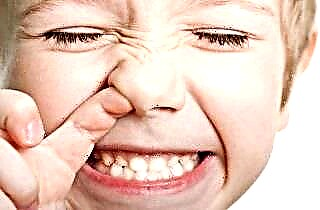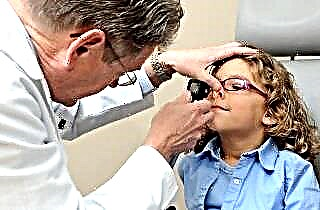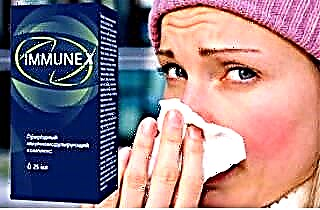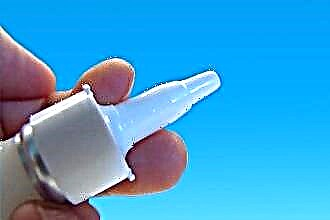Nosebleeds are common in children. There is nothing strange in this - the mucous membranes in the child's nose are very thin and easily injured. And the children themselves are very mobile - any child loves to run, play outdoor games, indulge in. And the nose in such pranks often suffers first, especially in boys. But it's not just trauma that can cause bleeding. Let's figure out for what reasons a child's nose can bleed and what needs to be done in such cases.
Blood in babies
 Let's start with the smallest ones. They do not yet lead such an active lifestyle that they could fall and bump their nose. Babies up to 5-7 months old spend most of their time in a horizontal position and rarely remain unattended by adults. But, nevertheless, sometimes nosebleeds in a baby can go.
Let's start with the smallest ones. They do not yet lead such an active lifestyle that they could fall and bump their nose. Babies up to 5-7 months old spend most of their time in a horizontal position and rarely remain unattended by adults. But, nevertheless, sometimes nosebleeds in a baby can go.
In a newborn, the reason is most often trivial - he just scratches himself in a dream or while awake. Babies up to 2-3 months can not yet coordinate hand movements well and can accidentally hook their face and stick a finger in their nose. If the nails are incorrectly cut (or the mother is simply afraid to do it), then the thin skin and mucous membranes are easily injured, and it seems to the mother that it is bleeding from the baby's nose. It is enough to put on special mittens on the handles and trim the nails in time, as the problem disappears.
The second common reason why a baby's nose starts bleeding is improper cleansing. It will not be possible to find out who was the first to use cotton swabs for cleaning the nose, but this idea was very bad, although it spread among mothers just rapidly. Not only is this the easiest way to injure the mucous membrane, but there is also a risk that the cotton wool will jump off and remain in the nasal passage.
Remember: only a doctor can put solid objects into the nasal passage of an infant for the purpose of examination or necessary medical procedures. You will not be able to control either the depth of insertion of the cotton swab, or the force of pressing on the walls of the nasal passages, which are literally pierced with capillaries.
Damage to the capillaries leads to the fact that blood flows from the nose in children after this method of cleaning it. Only soft cotton or gauze flagella moistened with saline, Aquamaris or warm sterile oil (sunflower, sea buckthorn, olive) can be used for these purposes.
In older children, especially from 2-3 years old, more serious causes can cause nosebleeds.
Non-infectious causes
If you turned away for a second, and the baby suddenly started crying, and his nose began to bleed, the most likely cause is injury. Broken knees or other abrasions and wounds confirm this especially eloquently. The first thing to do in this case is to calm the child down and stop the bleeding. We will tell you how to quickly do this below.
 Then you need to carefully examine the nose. If the blood was stopped quickly, touching the bridge of the nose does not cause severe pain, and its shape is not changed, then nothing terrible happened. The capillaries just burst from the blow. But if there is a large wound on the nose, severe swelling has appeared, it is not possible to quickly stop the blood, then a fracture is possible and then the baby needs urgent medical attention.
Then you need to carefully examine the nose. If the blood was stopped quickly, touching the bridge of the nose does not cause severe pain, and its shape is not changed, then nothing terrible happened. The capillaries just burst from the blow. But if there is a large wound on the nose, severe swelling has appeared, it is not possible to quickly stop the blood, then a fracture is possible and then the baby needs urgent medical attention.
Other non-infectious causes of nosebleeds in children include:
- Air is too dry. With insufficient air humidity in the room in which the child is for a long time, his delicate mucous membranes dry out, and dense crusts form in the nose. When they are removed from the nose, the baby may bleed, so this must be done very carefully.
- Overvoltage. Sometimes babies start bleeding when they cough or sneeze badly. This is due to the strong overstrain of the blood vessels, as a result of which they simply burst. You should not worry too much, but you need to pay attention to the cause of the fragility of the capillaries. Perhaps this is vitamin deficiency.
- Overheating. If during a walk in the hot season bleeds from the nose, most likely the reason is banal overheating. The baby must be immediately taken to the shade, wiped off his face, arms and legs with cool water, and air flow must be provided (you can simply fan him with a towel or newspaper). When bleeding is accompanied by vomiting, fainting, chills, severe headache, it is better to call an ambulance, heatstroke is possible.
- High blood pressure. In children, blood pressure rarely rises sharply and strongly. But if this happens, then nosebleeds may be the first symptom. Also, the child may complain of a headache, often there is nausea and vomiting. Before the doctor arrives, the bleeding must be stopped, it is better to put the baby to bed, and not to make a cold compress on the forehead.
- A sharp drop in temperature or pressure. Leads to spasm or severe dilation of blood vessels. If the walls of the capillaries are very thin, they burst and blood begins to run from the nose. This often happens on an airplane or when returning from extreme cold to warmth. This type of bleeding is not dangerous.
 Chemical or physical irritants: dusty and heavily gassed air, strong odors, household chemicals. Especially with constant exposure, they cause inflammation of the mucous membranes and their loosening. Over time, polyps can form, severe allergic reactions and even bronchial asthma develop.
Chemical or physical irritants: dusty and heavily gassed air, strong odors, household chemicals. Especially with constant exposure, they cause inflammation of the mucous membranes and their loosening. Over time, polyps can form, severe allergic reactions and even bronchial asthma develop.- Foreign body ingress. A small foreign body is very difficult to notice, but if it is a solid object that is stuck in the nasal passage and squeezes the mucous membranes, it causes nosebleeds in a child, often from only one nostril. In no case should you try to extract it yourself. The child should be taken to a doctor immediately.
- The use of vasoconstrictor drops. These drugs are generally not recommended for the treatment of young children - they greatly dry out the mucous membranes. And if you exceed the recommended dosages, then they crack and begin to bleed.
As soon as the above causes are eliminated, nosebleeds stop and do not recur again. If a child's nose bleeds regularly (at least two to three times a month), then most likely there is an internal reason for this.
Blood as a symptom
Sometimes a child's nosebleeds can be a symptom of a rather serious illness. Therefore, when this phenomenon is repeated often, regardless of age, the baby must be examined. This is an urgent need to do this if there are other recurring symptoms. The reason that the baby regularly bleeds from the nose may be the following diseases:
- Polyps and other benign formations. Polyps are an overgrowth of mucosal tissue that can be triggered by external or internal factors. This tissue has a changed structure, it is easily damaged, it often bleeds. Such bleeding may not be accompanied by other symptoms, but with a strong proliferation of polyps, the baby has a permanently stuffy nose (in one or both sides), he may complain of a feeling of pressure in the paranasal sinuses.
- Inflammation of the paranasal sinuses. Most often it is a complication after suffering respiratory diseases of a bacterial or viral nature. The infection, getting into the sinuses, provokes pyoinflammatory processes, severe runny nose and nosebleeds.
 Cardiovascular and renal diseases.Often lead to dramatic changes in blood pressure readings. This gives an additional load on the capillaries, which they cannot withstand and burst. Sometimes a strong increase in pressure can provoke poor kidney function. This can be found out only as a result of a comprehensive survey.
Cardiovascular and renal diseases.Often lead to dramatic changes in blood pressure readings. This gives an additional load on the capillaries, which they cannot withstand and burst. Sometimes a strong increase in pressure can provoke poor kidney function. This can be found out only as a result of a comprehensive survey.- Oncological diseases. Cancer (and not only of the respiratory system) can cause regular bloody rhinitis in the morning and frequent nosebleeds. Blood vessels become especially fragile during a course of chemotherapy, the drugs of which are very toxic.
- Hemophilia and other blood clotting disorders. They become the reason that the child is bleeding from the nose with the lightest damage to his mucous membrane and it is very difficult to stop this bleeding, often this requires the use of special drugs. Long-term use of blood-thinning drugs, for example, "Aspirin", can also cause such an effect.
Treatment in any of the above ways is necessary, since nosebleeds are only a symptom, but they will not stop until the underlying cause is eliminated. Only a doctor should select medications based on the results of the tests performed. Self-medication can aggravate the situation and cause the nose to bleed more frequently.
In some cases, conservative treatment is not enough. So, if after several courses of therapy the polyps in the nose or sinuses do not decrease, it is better to remove them surgically. Otherwise, they can cause not only frequent bleeding, but also the development of chronic respiratory diseases.
How to stop bleeding
If a child's nose bleeds not much, then with the right actions it is quite easy to stop it. The main thing is not to panic, so that the anxiety is not transmitted to the already frightened baby. Here's what to do:
 sit him on a chair, on his hands or just on the floor (so that he does not fall if he gets dizzy);
sit him on a chair, on his hands or just on the floor (so that he does not fall if he gets dizzy);- tilt his head down (and not lift up, as many do!);
- lightly squeeze the bridge of the nose with your fingers on both sides;
- ask the baby to breathe calmly and slowly through the mouth;
- hold the nose for 5-7 minutes.
Usually, after these actions, the blood stops flowing. Then you can apply a cold compress to the bridge of the nose. If it is ice, keep it for no more than 5 minutes, then remove it and, if necessary, apply it again after a while.
When a child's nose bleeds too much, sterile gauze swabs can be inserted very carefully into the nasal passages. They will clamp the capillaries and the bleeding will stop. You can keep them in your nose for no longer than 15 minutes.
But if, despite all the measures taken, the blood continues to flow, a consultation with a doctor and, possibly, an ambulance is necessary.
Prevention measures
No amount of preventive measures will protect a child from nose injuries. In childhood, they are inevitable. But if you explain the elementary measures of personal safety to the grown-up kid, then there is a high probability that it will still be possible to do without serious injuries. And children under 2-3 years old simply cannot be left unattended for a long time.
Other preventive measures will help reduce the risk of nosebleeds:
- strengthening of immunity, hardening procedures - will allow you to get sick with respiratory diseases less often;
- compulsory treatment of the common cold - will prevent the development of chronic diseases of the nose and sinuses;
 compliance with cleanliness and temperature conditions in the child's room will eliminate the negative influence of external factors as much as possible;
compliance with cleanliness and temperature conditions in the child's room will eliminate the negative influence of external factors as much as possible;- regular preventive medical examinations will allow diagnosing serious diseases of internal organs at an early stage;
- varied high-grade and high-quality nutrition, rich in vitamins and microelements, will prevent vitamin deficiency and capillary fragility;
- proper and regular cleansing of the nasal passages will not injure the mucous membranes and eliminate the congestion of mucus.
As you can see, everything is important in caring for a baby: regimen, nutrition, living conditions, appropriate care. But most importantly, trust your pediatricians and don't self-medicate. Very often, the wrong actions of parents lead to the fact that such a small problem as nosebleeds becomes a big problem that requires long-term treatment.

 Chemical or physical irritants: dusty and heavily gassed air, strong odors, household chemicals. Especially with constant exposure, they cause inflammation of the mucous membranes and their loosening. Over time, polyps can form, severe allergic reactions and even bronchial asthma develop.
Chemical or physical irritants: dusty and heavily gassed air, strong odors, household chemicals. Especially with constant exposure, they cause inflammation of the mucous membranes and their loosening. Over time, polyps can form, severe allergic reactions and even bronchial asthma develop. Cardiovascular and renal diseases.Often lead to dramatic changes in blood pressure readings. This gives an additional load on the capillaries, which they cannot withstand and burst. Sometimes a strong increase in pressure can provoke poor kidney function. This can be found out only as a result of a comprehensive survey.
Cardiovascular and renal diseases.Often lead to dramatic changes in blood pressure readings. This gives an additional load on the capillaries, which they cannot withstand and burst. Sometimes a strong increase in pressure can provoke poor kidney function. This can be found out only as a result of a comprehensive survey. sit him on a chair, on his hands or just on the floor (so that he does not fall if he gets dizzy);
sit him on a chair, on his hands or just on the floor (so that he does not fall if he gets dizzy); compliance with cleanliness and temperature conditions in the child's room will eliminate the negative influence of external factors as much as possible;
compliance with cleanliness and temperature conditions in the child's room will eliminate the negative influence of external factors as much as possible;

